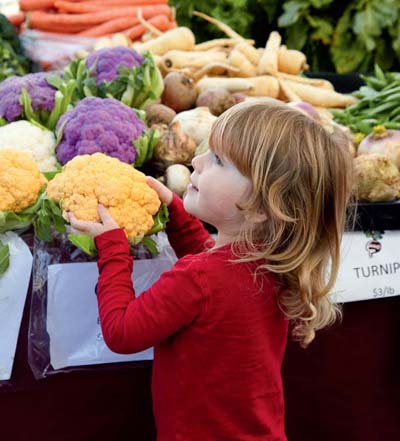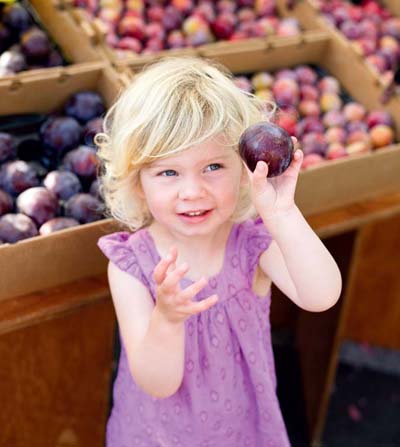
Every Sunday, we head to our local farmers’ markets. Leslie meets her nieces, Monique and Sarah, at the Temescal Market in Oakland, while Ethel brings her twins, Oscar and Raphael, to the Alemany Market in San Francisco. The best thing about visiting a farmers’ market is that you get to sample what’s being sold—and we sample everything. The twins amble about, stuffing their mouths with strawberries and blueberries. Monique and Sarah like to sample cherry tomatoes. We enjoy seeing other families and talking to farmers as we load our bags with seasonal produce.
Even though our farmers’ markets are in the midst of urban activity, going to the market makes us feel as if the farm has come to us. We pick up new facts about what we buy and new ideas for using what we tote home. José, who sells beautiful pears, might offer a wedge from a new Asian cultivar. Will, the strawberry vendor, is eager to point out that strawberries have their seeds on the outside. We might learn a tip for baking plums or discover a new type of pumpkin for carving. For the kids, going to the market is akin to going to a big party attended by lots of people having a good time. There is something different to taste and to do on every visit. Around the country, farmers’ markets like ours have sprouted up in cities and towns, giving urbanites the opportunity to experience the bounty of the seasons.
The kids love the market, and cooking from our market purchases is one of our favorite ways to spend time with them. Throughout the year, we make recipes that highlight the versatility and seasonality of produce. Shopping and preparing something that celebrates food and the seasons have become weekly rituals we all look forward to.
If you’ve picked up this book, chances are you already shop at a farmers’ market and are looking for new ways to enjoy the experience with your kids. Cooking after our market visits has inspired us to create dozens of food and craft recipes that double as family projects.
True to the spirit of a farmers’ market, this book is organized by the seasons. For each season, we offer profiles of our favorite farmers’ market fruits and vegetables, with handy tips on how to choose and store them, along with a list of varieties we particularly like. Most important, we share recipes that celebrate the time of year: dipping beet-dyed Easter eggs in spring, making berry jam in summer, drying grapes in fall, fermenting sauerkraut in winter. Many projects, such as dried-fruit bracelets, creamy apple butter, and berry-dyed T-shirts, make terrific seasonal gifts. Recipes such as tomato ketchup and cucumber pickles teach kids that foods they thought only came in bottles from the store can be prepared at home.
In choosing the recipes, we thought carefully about what made a recipe successful for kids and came up with the following criteria:
1. The recipes feature produce as the main ingredient and/or give kids tactile experience with the ingredient. Watermelon must be juiced for watermelon gelatin, for example, and red beets star in magenta beet cupcakes.
2. The recipes are fun for kids to make. Rolling dough, shelling beans, and mixing ingredients are easy and enjoyable tasks.
3. The recipes celebrate the seasons and seasonal holidays: making nectarine frozen yogurt in summer, mashing sweet potatoes with candied pecans for a Thanksgiving feast, sugaring lemon peel for holiday sweets.
4. The recipes often double as crafts and gifts for kids to give to family and friends. Jams, candies, and other preserves are as exciting to give as they are to make.
5. The recipes must be delicious and fun to eat.
There are many reasons we like to shop with kids at the farmers’ market. Not only is the activity fun, but kids have the opportunity to meet the growers and learn about where food comes from. Once kids learn this, they will connect growing to cooking and ultimately to eating. Giving kids the power to make choices about what to buy and how to cook is a great way to encourage them to try new foods and to develop lifelong healthful eating habits. Tasting the varieties and learning their names might make even the pickiest young eaters change their minds about something they disliked in the past—or at least keep them entertained until the shopping is done.
Our hope is that this book will help you show your kids how to buy fresh, seasonal foods at the market and how to use them at home. We also hope that going to and cooking from the farmers’ market will become a ritual in your lives just as it has in ours.


